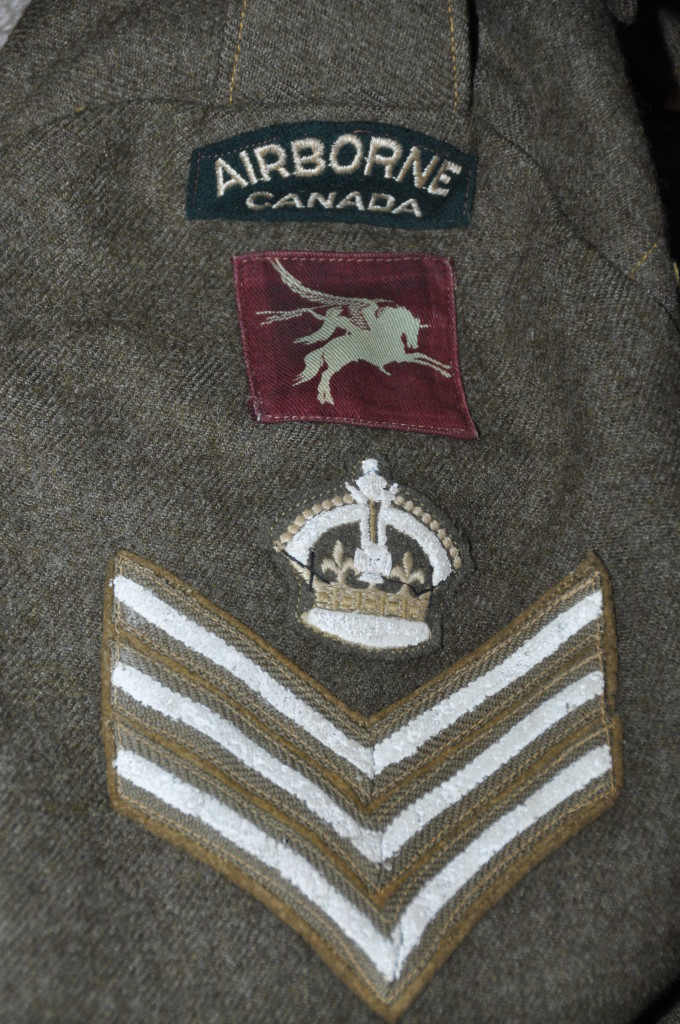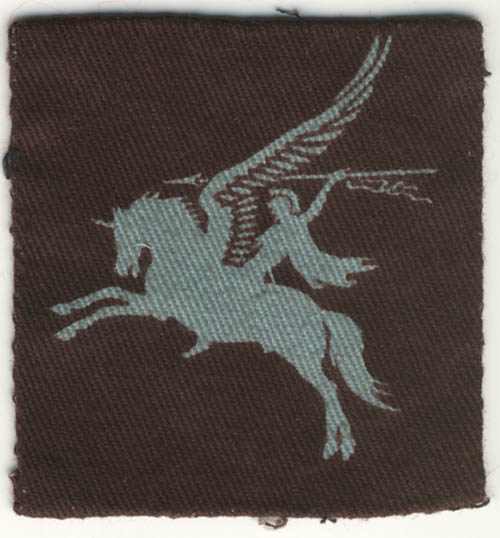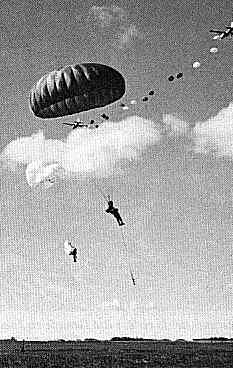
1942-1944 shoulder title as worn in Canada and overseas. The 1 Canadian Parachute Battalion issued their “1 Canadian Parachute Battalion” shoulder titles before D-Day June 1944.

The British airborne formation patch for 1 Airborne Division and 6 Airborne Division. This was also worn by Canadians with 1 Canadian Parachute Battalion. It depicts the first “airborne warrior” – Bellerophon riding the flying horse Pegasus. This symbol was also used as a formation sign on their vehicles.
Note about book: ” BASTARD SONS “
by Bernd Horn “In a rapidly changing world, where the unpredictable shape of conflict will continue to be the order of the day, can our country further risk its beliefs, honour and very existence by excluding the Canadian Airborne Regiment, whose identity naturally harnesses some of the most versatile committed and inspired soldiers our nation has to offer?” -Colonel. Peter G. Kenward, Last Commanding Officer, The Canadian Airborne Regiment Bastard Sons is the long awaited examination of the legendary Canadian Airborne Regiment. In this important new book, Lieutenant-Colonel Horn brings the reader through the whole of the Airborne experience, by offering a detailed and thoroughly researched account of its history. With the current international circumstances, this book should appeal to all Canadians, through its consideration of homeland defence, the need for an elite military unit, and the relationship between the political and military establishments of Canada. Throughout its pages, Bastard Sons also offers a revealing and controversial assessment of why the Canadian Airborne Regiment was disbanded by government order in 1995. It is a rare look into the decision making process in Ottawa, with its personalities and motives, heroes and villains, causes and betrayals. Lt-Col. Horn expertly captures the “schizophrenic” attitude of Canadian governments, the military and public towards the Airborne. From the creation of the postwar Mobile Striking Force and Defence of Canada Force, to the demise of the Airborne Regiment, the Army’s key problem remained its inability to find a viable, long-term role that made airborne forces “indispensable.” This dilemma stemmed from the fact that Canadian political and military leaders never believed that any justifiable, strategic role existed for airborne forces; the existence of the latter was instead the fulfillment of political requirements. Lt-Col. Horn does more than just analyze the politics behind the birth, development and demise of the airborne forces. He pays tribute to those who served in or supported the Regiment and its predecessors during the 53 years of the Canadian airborne experience. His impressive research and documentary evidence proves that the vast majority of Canada’s paratroopers did their duty faithfully and honourably. Bernd Horn is a serving officer with the Canadian Armed Forces and is a former member (1993-95) of the Canadian Airborne Regiment. He holds a PhD in War Studies from Royal Military College, Kingston, where he is an adjunct professor of history. Lieutenant-Colonel Horn was at the time the Commanding Officer of 1 RCR in Petawawa, Ontario. Hard cover. 288pp 6X9″ b/w photos & illustrations 1-55125-078-0 A good book was about the overall history of Canadian Airborne Forces is called: IN SEARCH OF PEGASUS by Bernd Horn and Michel Wyczynski. Published 2001 by Vanwell Publishing Ltd. , St. Catharines, Ontario. ISBN 1-55125-039-X The following lists many airborne units that Canadians served in, but not all:1 Canadian Parachute Battalion 1942-45
2 Canadian Parachute Battalion (see First Special Service Force as this was one name for the Canadian component of the FSSF)
Canadian Parachute Training Company (in England 1943-45)
First Special Service Force (FSSF – “The Devil’s Brigade”) 1942-44
S.O.,E. (Special Operations, Executive) 1940-45 Sabotage organization in World War II S.O.,E. had two training schools in Canada.Camp X (aka Project J, and STS 103 – Special Training School 103)
One of the S.O.,E. training camps in Canada. The other one was for Force 136 in B.C. Camp X was, contrary to the incorrect info in “A Man Called Intrepid” basically a basic training and screening school. The OSS (predecessor to the CIA) did some of its earliest training there. Interestingly I have discovered that a distant relative owned the property which was taken over to create Camp X! Force 136 (see S.O.,E.) Far East Branch of S.O.,E. Many Chinese-Canadians, Japanese-Canadians and others served in it. Some Chinese-Canadians were sent by Force 136 to serve with the Malayan People’s Anti-Japansese Army (MPAJA).S.A.S. (Special Air Service) World War II raiding unit.
Some Canadians served in 1 & 2 SAS. 5 SAS (Belgian) originally trained in Canada. They used a maple leaf as a symbol as a result. Eddie Blondeel was the C.O. (Post-WWII SAS collar badges shown). S.I.S. (Secret Intelligence Service, MI-6) British spy organization. The ‘real’ James Bond’s organization.MI-9 (Military Intelligence 9) (British World War II Escape Organization)
Canadian members included Lucien Dumais and Ray Labrosse. See “The Man Who Went Back”. Canadian Special Air Service Company – 1947-49 Raised and commanded by Guy d’Artois who had served in R22eR, F.S.S.F., S.O.,E. (F Section), and after the SAS Coy was disbanded, he served again with R22eR in Korea. I had the pleasure of meeting him and feel he was one of the ultimate Canadian airborne soldiers. Even his wife was a combat parachutist! She too served with S.O.,E. behind the German lines in France.C.J.A.T.C. Canadian Joint Air Training Centre

Mobile Strike Force 1948-58
Canadian Airborne Regiment 1968 – 1995
This proud formation was disbanded by politicians in a very controversial and demoralizing action. Joint Task Force II (aka JTF 2) c.1995 – Present A secret SAS style unit based near Ottawa, Ontario, Canada. See book “Tested Mettle” by Scott Taylor and Brian Nolan. This group was photographed delivering Afghan prisoners to US Forces. They were recognizable by their green camo uniforms in the desert environment.